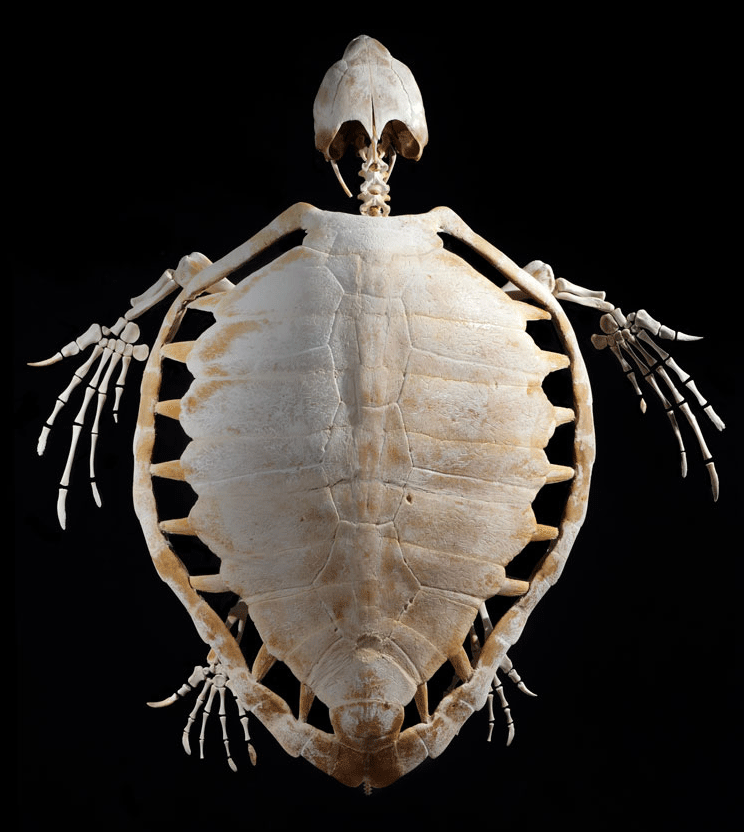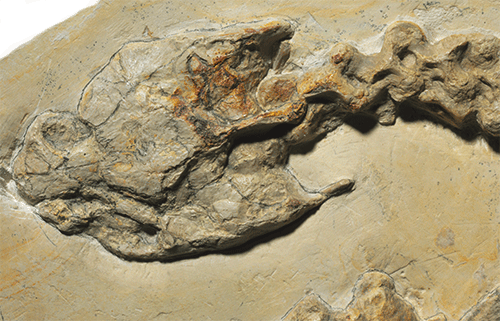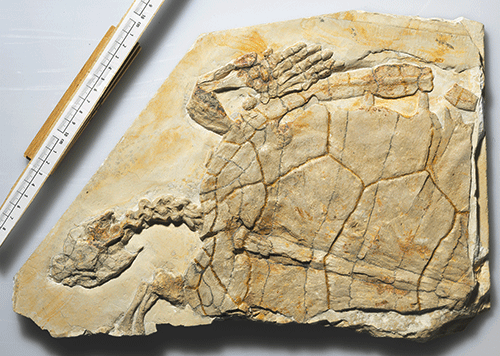March 2025: Sea turtle
Palaeomedusa testa von Meyer
Late Jurassic, ca. 150 million years

The turtles (Testudinata) are an ancient group of reptiles that first appeared in the Upper Triassic period, around 230 million years ago. Their relationship to other groups of reptiles has long been controversial; while it was previously assumed that the turtles represented survivors of an otherwise extinct, very basal group of reptiles, the so-called parareptiles, today they are regarded as being more closely related to the archosaurs (crocodiles and birds). The reason for this uncertainty is the extremely unusual body plan of turtles, in which practically the entire body, including the shoulder and pelvic girdles, is surrounded by a shell that partly consists of the ribs, while in other land vertebrates the ribs lie under the shoulder girdle. Only in the last 25 years have new discoveries of transitional forms from the fossil record as well as molecular genetic studies helped to clarify the question of the origin of turtles.
Foto: Skeleton of a recent loggerhead sea turtle (Caretta caretta) showing the lateral reduction of the carapace and the forelimbs that have evolved into paddles (Wikipedia Creative Commons, photo by Daniel Calatayud Belinchon)
Although there are currently only about 360 species of turtles, their long evolutionary history has made them a very diverse group, both anatomically and ecologically. All present-day representatives of the group belong to one of two large subgroups, the Cryptodira (“hidden neck turtles” that can pull the head back under the shell) or Pleurodira (“side neck turtles” that can move the head under the shell by bending the neck to the side). The Cryptodira include todays only reptiles fully adapted to life in the sea, the Chelonioidea (leatherback turtles and true sea turtles, such as the loggerhead turtle). However, in the evolution of turtles several groups have adapted to life in the sea, including the Thalassochelidia of the Jurassic period, which includes Palaeomedusa. These turtles are still outside of the division of modern representatives into Cryptodira and Pleurodira and died out already at the end of the Jurassic period (around 145 million years ago). Similar to today’s sea turtles, at least some of these animals show a reduction in the bony shell, but their front and hind legs are not converted into flippers. Nevertheless, the Thalassochelidia were apparently a successful and species-rich group that lived in the subtropical to tropical shallow seas on the northern edge of the ancient Mediterranean, the Tethys, including in the area of the Solnhofen limestones, which today outcrop in the valley of the Altmühl in Bavaria.
Oliver Rauhut
 Skeleton of Palaeomedusa testa SNSB-BSPG AS 818 |  Skeleton of Palaeomedusa testa, SNSB-BSPG AS 818 |



